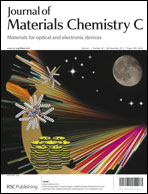Diphenyltriacetylenes: novel nematic liquid crystal materials and analysis of their nematic phase-transition and birefringence behaviours†
Abstract
Improvements in birefringence properties of LC materials are actively being pursued because of the increase in their applications in optical devices. 1,6-Diphenyl-1,3,5-hexatriyne, i.e., diphenyltriacetylenes (DPTAs; number of acetylene units, n = 3) are expected to have wide nematic mesophases and exhibit extremely high birefringence properties because of the high aspect ratio of their conjugated structures. Therefore, we synthesised DPTA derivatives as novel, highly birefringent nematic liquid crystal materials. The derivatives exhibit stable enantiotropic nematic phases with longer alkoxy carbon chain lengths (i.e., with dodecyloxy groups, m = 12). High birefringence values of Δn = 0.46 at 550 nm and 140 °C and a high extraordinary refractive index (ne) of over 2.0 were exhibited for triyne DPTA–OC6. Furthermore, we investigated the effect of the acetylene bond on the nematic transition behaviours and refractive index parameters of the conjugated oligoyne or polyyne compounds with two terminal aromatic rings. An increasing number of acetylene units (n = 1–3), i.e., extended conjugation, led to wider nematic phases and higher birefringence; the increment in Δn per acetylene unit was estimated to be approximately 0.14.


 Please wait while we load your content...
Please wait while we load your content...